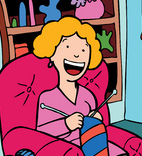Hand knitting is a craft that is enjoyed by many people, but if you’re way past the novice level and want to take on the challenge of knitting larger patterns, or your knitting business is at the stage where you can’t keep up with demand by hand knitting alone, or you just want to be able to knit up more items per hour, then maybe it’s time for you to invest in a knitting machine.
When you knit by hand, you create one stitch using two needles. Imagine how much work you can do with a knitting machine that constructs an entire row all at once!
There are three common types of knitting machines: bulky machines, standard beds, and mid-gauge versions. Some are simple looms while some can be highly complex with buttons and dials operating computerized functions.
Heavy sweaters are knitted on a bulky machine, which has needles set 9mm apart and hook and latches that are large enough to work on thick yarns. Bulky machines can also carry out Fair Isle, tuck, slip, lace, intarsia, and other knitting techniques. Studio, Brother knitting machines, and Silver Reed are popular brands of chunky machines.
These knitting machines can be mechanical knitting machines, which allow you to choose from selection of pre-punched cards as well as create your own patterns. Electronic knitting machines have more flexibility and a wider range of uses. They can have around 300 patterns stored in memory which you can turn upside down, mirror, reverse, or double the width or length.
Standard knitting machine beds are typically used to knit suits and lace curtains. Needles are placed 4.5mm apart and the hook and latches are smaller than those on bulky or mid-gauge machines. A standard bed knitting machine usually offers numerous stitch type options and can accommodate very thin yarns.
Electronic standard bed knitting machines allow you to choose from more than 650 templates with more room for customized patterns. Advanced models like the Brother KH970 come with an automatic lace carriage and a computer program that enables you to knit the same sweater with different yarns, gauges and stitch design without re-entering the garment piece.
Mid-gauge knitting machines produce the closest quality to hand-knitted fabrics. With needles set 6.5mm apart, these machines can knit a wide variety of yarns, including baby, sport and worsted types. Lace is done by hand and most models do not have stored patterns or automatic selection of needles. Mid-gauge machines can do some of the most common knitting stitches like stockinet, slip and tuck, as well as techniques involving weaving, plating and ribbing.
When choosing a knitting machine, decide on what type of yarn you want to use, what features you need, and how much you’re willing to spend. A row counter, ribber, and tension mast are necessities in a knitting machine. Some special features you may want to consider are lace carriages, garter bars, punch cards, automatic color changers, and intarsia carriages.
It is best to get a knitting machine with these extended features so that as you get more confident with machine knitting, your machine will be able to grow with you and allow you to take on more challenging projects.



